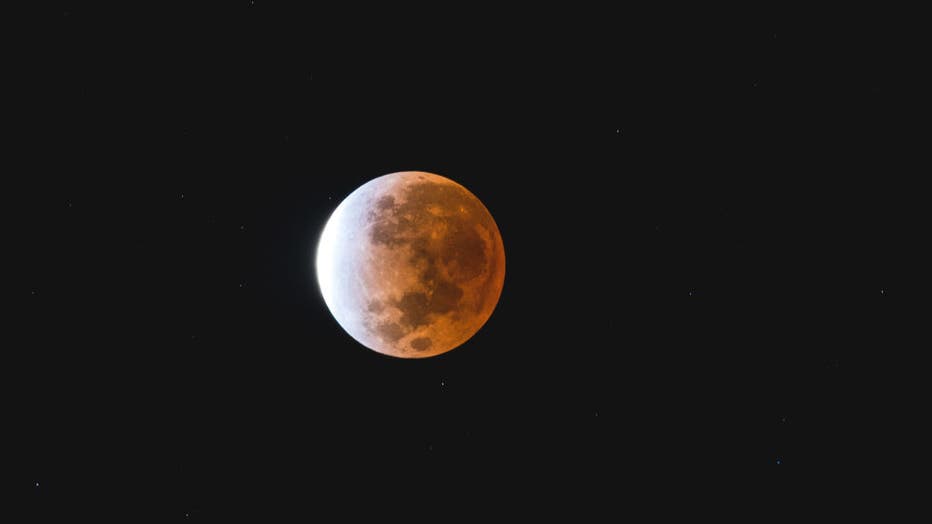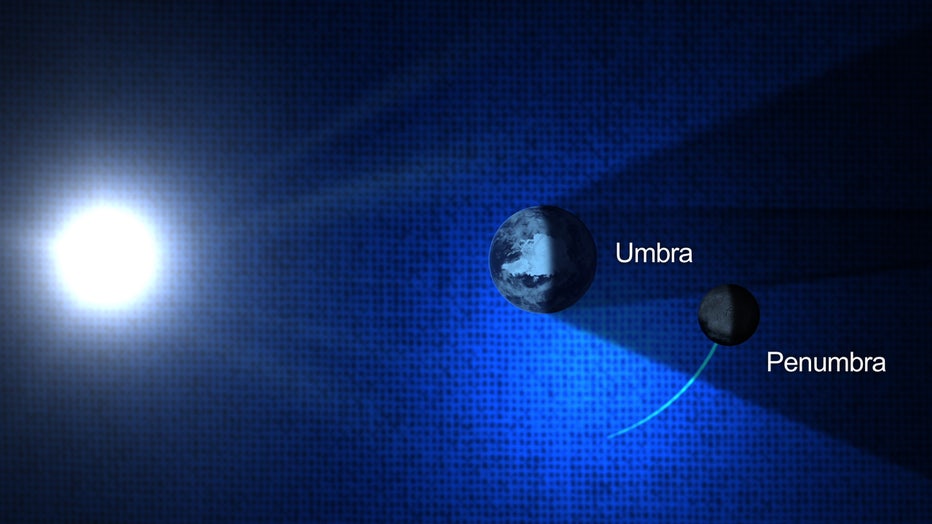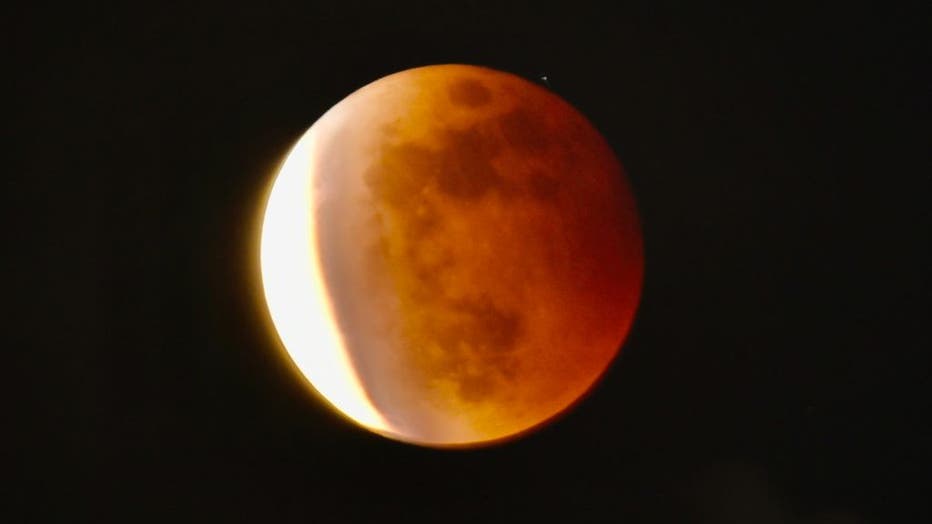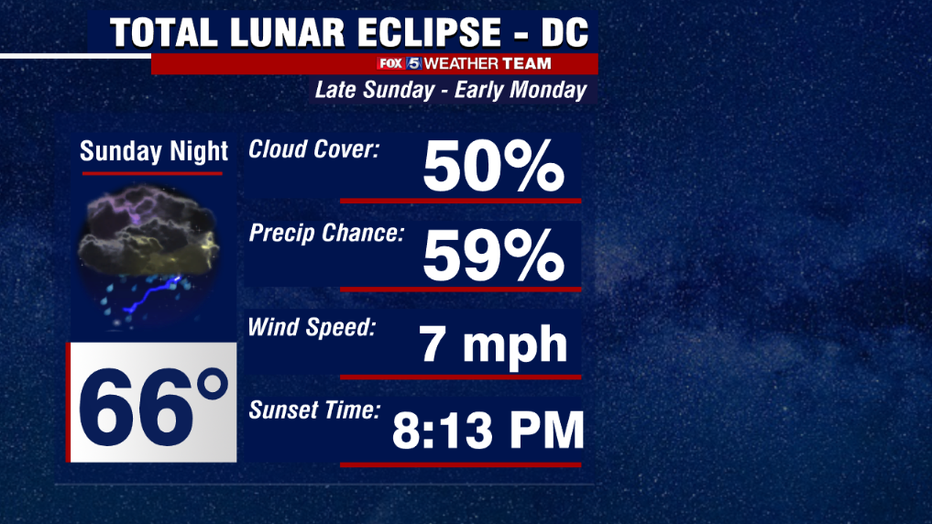MOON WATCH: Total Lunar Eclipse To Grace D.C. Skies Sunday Night
Nothing fascinates us quite like the endless abyss of the night sky above. Space is a very interesting place, and this weekend it will put on a show for skyward viewers across the eastern half of the United States. For the first time since 2019, a total lunar eclipse can be seen for a few hours, late Sunday night into the very early morning hours of Monday morning.

View of the Moon during a partial lunar eclipse on November 19, 2021 in Austin, Texas. (Photo by Rick Kern/Getty Images)
Download the FOX 5 DC News App for Local Breaking News and Weather
First off, what exactly is a lunar eclipse? It actually has a very simple explanation! It is when the earth passes between the moon and the sun, so that the moon falls within the earth's shadow. This is not to be confused with it's cousin, the solar eclipse, which is where the moon passes between the sun and earth. By simple occurrence, both solar and lunar eclipses are not that rare. There is an average of three solar and three lunar eclipses a year in fact. The key difference is that during a solar eclipse, the moon's shadow falling upon the earth only covers an area about 50 miles wide, making it harder to fall within this "zone of totality" during any given eclipse. Since the Earth casts a much bigger shadow however, a total lunar eclipse will often be visible across many continents.

NASA Artist Imagery Showing The Earth Casting Shadows On The Surface Of The Moon.
Ever look at your shadow on a sunny day and notice that you don't just cast one, but two? One that appears to be much lighter, while a darker on sits in the middle? This is exactly what happens with earth and the moon. That "lighter shadow" is where the light is being partially, but not fully, blocked. This zone of lighter shadow from earth is called the Penumbra. When the moon moves into the Penumbra, it will get slightly dimmer, but often times so subtly that the casual observer might not even notice the difference. The darker shadow, where the light from the sun is being fully blocked, is called the Umbra. It is when the moon moves into this shadow that it begins to take on the reddish color that we know so well with lunar eclipses.

A full blood moon is seen during a partial eclipse in Taipei on May 26, 2021 as stargazers across the Pacific are casting their eyes skyward to witness a rare "Super Blood Moon." (Photo by SAM YEH/AFP via Getty Images)
That reddish color that coats the moon is actually the same effect that makes our sky here on earth turn vivid colors of orange and yellow during sunrises and sunsets. As the light from the sun hits the earth, particles in the atmosphere scatter it, like a prism. When sunlight is direct, we see the sky blue, but as the sun is setting and it has to travel through more of the atmosphere. The blue light is all scattered away and we're left with just the yellows, oranges, and reds. When the moon passes into this dark shadow of the Earth, the only light that is still able to reach it are those same hews. The more dust, smog, or ash in the atmosphere on the day the of the eclipse, the more red the moon will appear!

So when is this total lunar eclipse for our region? Well to see it you will have to be willing to sacrifice a little bit of sleep on Sunday night as it will not occur until late in the evening. The moon will start the process of entering the Penumbra, and slightly dimming, just after 9:32pm in the evening, but it will not begin to change over to the familiar reddish color until about an hour later as the moon begins to enter the Umbra. By 11:30pm, the moon will be fully immersed in the Umbra and be fully coating in a shading of red, with the deepest red being around 12:11am on Monday. You'll have about an hour and a half to see it fully immersed before it starts to exit the Umbra, with the color fading just before 2am.

SUBSCRIBE TO FOX 5 DC ON YOUTUBE
This will be the first total lunar eclipse for the DC region since 2019, and the last until November. So the key question is, will we be able to see it? Or will it be obscured by weather? Sunday will likely be the hottest day of the week, and that heat combined with some humidity could help bubble up some afternoon showers and thunderstorms which could linger into the evening hours. These should start to diminish in number after sunset, but some clouds will likely remain scattered across the region well into the night. That's not to say we are expecting overcast conditions, so yes you should be able to see the lunar eclipse if you stay up late enough on Sunday night, though it will likely be partially (or even totally) obscured by clouds at times. But we believe that those wanted to catch a few glimpses of the blood moon should be able to do so.

